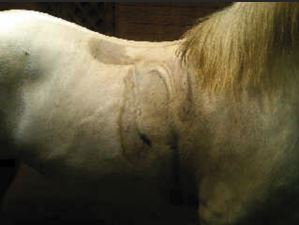
Horses sweat just like humans in order to regulate their body temperature. Horses have what are called “apocrine” sweat glands. There is a gland at the base of every hair. Therefore the number of sweat glands is related to hair density. The neck sweats more than the back or quarters due to differences in sensitivity of the sweat glands not due to the number of them.
In a moving horse the air movement over the neck is higher than over the back or croup. It’s why horses sweat more on the neck not because of more glands but because of a higher sensitivity to temperature. Areas like the neck or flank area have a broad and open surface area to allow the natural influence of air and wind to cool the body with the help of sweat. That is why the large saddle flaps (the bottom flap when there are two, the monoflap when there is one) are called sweat flaps.

The horse will be able to sweat under the saddle when friction and air circulation are present – in other words, no sweat will form in the areas which are in constant contact without movement on the horse’s back. Most of the friction will then occur at the front (pommel area) and back (cantle area) of the saddle, since presumably the center of the saddle (where there is the least amount of movement on the back) has constant pressure.
In the front, the shoulder will rotate upwards and backwards anywhere between 4-6” during movement. The latter third of the saddle should ‘rock’ slightly in accompaniment of the horse’s motion. In the center of the saddle where the billets work to keep the saddle in position and still, and where the gullet plate and stirrup bars assist in keeping the saddle off the horse’s spinal processes, there must be no movement or twisting going on.
Since there is no real amount of friction (at least, there shouldn’t be) under the stirrup bars or at the gullet plate at the withers, this will be the area where the horse will sweat least – and last. Of course, this will also depend on season, coat length, where/how the horse is stabled, breed, overall health and condition – and how he is ridden. Large kidney shaped (6-8” long) dry spots are acceptable under the stirrup bar. But dry spots on the saddle support area that have a circumference of around an inch, could indicate points of concentrated pressure which will be a source of discomfort to your horse.
https://www.youtube.com/embed/ssAnZqf6C6g
Author of ‘Suffering in Silence – The Saddle fit Link to Physical and Psychological Trauma in Horses’ (2013) Jochen Schleese teaches riders and professionals to recognize saddle fit issues in Saddlefit 4 Life lectures and seminars. We help you find answers in a personal 80 point Saddle Fit Diagnostic Evaluation.
1-800-225-2242 www.Saddlefit4life.com











